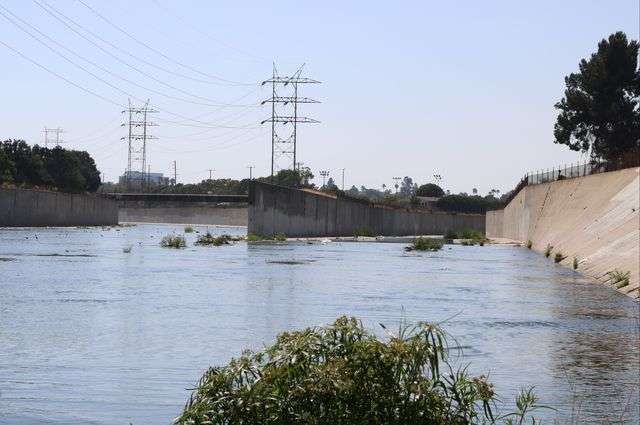More local water for Los Angeles could mean a drier Los Angeles River

Local leaders are working to make greater Los Angeles more reliant on local water in order to prepare for a hotter and more crowded future. A UCLA study published today is a reminder that achieving water independence would require a delicate balancing act—in particular for how the region manages the Los Angeles River.
The study, the most comprehensive analysis to date of integrated water management strategies for the river, is intended to guide local officials in planning for the river's future. It considers the implications of Los Angeles increasing its use of reclaimed water, and the possible impact of diverting and collecting more stormwater than it currently does—including the question of whether those actions would leave enough river flow for residents' recreational use and for plant and animal habitats.
For example, reducing the amount of stormwater or reclaimed water that rushes through the river into the ocean would also mean less river water for kayakers and local wildlife.
Drawing from 60 years of flow data, researchers modeled changes in flow and water quality to understand the impacts potential measures such as the use of porous pavement or the creation of man-made ponds would have for reducing stormwater pollution.
"What we've learned is that the L.A. River can't be everything to everyone all the time," said Katie Mika, a postdoctoral scholar at UCLA's Institute of the Environment and Sustainability and one of the study's lead researchers.
The study examined the Los Angeles River watershed—the area around the river and its tributaries—which begins in the southwest corner of the San Fernando Valley and ends at the Pacific Ocean and covers 825 square miles. Today, the river is at a turning point, with more than $1 billion in revitalization projects planned or already underway.
"With such tremendous local, state and federal investment and interest in the Los Angeles River, this study is essential for leaders to determine the future of its watershed, the river and its tributaries," said lead researcher Mark Gold, associate vice chancellor for environment and sustainability at UCLA.
Among the key findings:
- Stormwater pollution reduction measures—some of which are already in place—designed to treat a major rainstorm would significantly reduce river pollution, but not enough to meet federal Clean Water Act standards for toxic metal contamination in the river. These measures will also result in increased groundwater recharge that could provide enough water for more than 1 million Angelenos per year.
- If applied to the entire watershed, the city's Low Impact Development ordinance, which requires developers to capture water for reuse or infiltration (meaning the water is made to seep into the ground), would result in an increase of 2,000 acre-feet of infiltrated runoff, a 7 percent reduction in copper and a 10 percent reduction in zinc by 2028. (Copper and zinc in the water come from sources like tire dust and automotive brake pads from the surrounding paved areas.)
- The region could dramatically increase the use of groundwater, recycled water and stormwater runoff. For example, new green infrastructure projects could result in more stormwater capture, which would help replenish the groundwater supply for later use.
- In the past 60 years, flows in the Los Angeles River have increased more than tenfold due to increased urbanization, decreased watershed permeability and the discharge of more than 30 million gallons per day from three wastewater treatment plants. Today's average flow of 274,000 acre-feet per year provides tremendous potential for runoff capture to augment local water supplies.
- If Los Angeles reuses all of its recycled water without discharging it to the river for environmental reuse, it would lead to a nearly dry river for much of the year, which would have a major impact to recreation and aquatic life.
"This type of modeling analysis provides invaluable information on the potential tradeoffs among various stormwater pollution control measures that will improve water quality," said Terri Hogue, one of the study's lead authors and a professor at the Colorado School of Mines.
The research team also included UCLA professor Stephanie Pincetl, and former UCLA graduate student Kim Truong; and postdoctoral scholar Laura Read, and researchers Elizabeth Gallo and Ryan Edgley, all of CSM.
The study is part of the Sustainable LA Grand Challenge, a UCLA research initiative that aims to transition L.A. County through cutting-edge research, technologies, policies, and strategies to 100 percent renewable energy and 100 percent locally sourced water, while enhancing ecosystem and human health, by 2050.
More information: LA Sustainable Water Project: Los Angeles River Watershed. escholarship.org/uc/item/42m433ps
Provided by University of California, Los Angeles




















